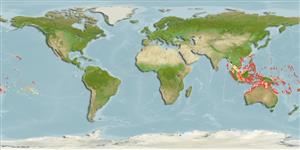>
Gobiiformes (Gobies) >
Gobiidae (Gobies) > Gobiinae
Etymology: Eviota: No etymology given, suggested by Christopher Scharpt: from Latin 'eu' for 'true' and 'iota' for anything very small, in combination 'truly very small' referring to it as being the smallest vertebrate at the time it has benn described by Jenkins (thus, making the suggestion by Scharpt plausible..
More on authors: Lachner & Karnella.
Environment: milieu / climate zone / depth range / distribution range
экология
морской ассоциированный с рифами; пределы глубины ? - 44 m (Ref. 86942). Tropical; 25°N - 24°S
Western Pacific: Australia. Records from other areas may represent different species, from Cocos-Keeling Islands throughout the East Indies; in the south from Bali eastwards to Samoa and New Caledonia and southward to Australia (Scott Reef and the southern Great Barrier Reef); in the north extending to the Yaeyama Islands of Japan and eastward to Micronesia (Palau, FSM - Truk and Enewetak, and the Marshall Islands). Records from Fiji refers to Eviota karaspila.
Size / Вес / Возраст
Maturity: Lm ? range ? - ? cm
Max length : 3.0 cm SL самец/пол неопределен; (Ref. 48637)
Краткое описание
определительные ключи | морфология | морфометрия
колючие лучи спинного плавника (общее число) : 5 - 7; членистые (мягкие) лучи спинного плавника (общее число) : 8 - 10; колючие лучи анального плавника: 1; членистые (мягкие) лучи анального плавника: 8 - 9. Characterized by semi-transparent body with red-brown internal bars; irregular reddish blotches on nape; presence of intense black spot above gill opening; three red blotches separated by white or yellow bars on side of belly; base of pectoral fin with narrow white band; longitudinal scale series 23-25; ctenoid scales, absent on head and breast; separated pelvic fins, thin membrane joining bases; depth of body 6.5-7.7 in SL (Ref. 90102). Dorsal to anal fin-ray formula 9/8 (Ref. 116739).
Found on rocks of corals reefs in the infralittoral zone (Ref. 559, 48637). Solitary or in groups, resting at bottom (Ref 90102). Spawning appears to be repeated on a regular cycle, semilunar or every 14 days (Ref. 116739).
Life cycle and mating behavior
Maturities | размножение | Spawnings | Egg(s) | Fecundities | личинки
Myers, R.F., 1991. Micronesian reef fishes. Second Ed. Coral Graphics, Barrigada, Guam. 298 p. (Ref. 1602)
Статус Красного Списка МСОП (Ref. 130435)
Угроза для людей
Harmless
Использование человеком
дополнительная информация
инструменты
Специальные отчеты
Скачать в формате XML
ресурсы в Интернет
Estimates based on models
Preferred temperature (Ref.
123201): 25.4 - 28.9, mean 27.9 °C (based on 524 cells).
Phylogenetic diversity index (Ref.
82804): PD
50 = 0.5000 [Uniqueness, from 0.5 = low to 2.0 = high].
Bayesian length-weight: a=0.00708 (0.00333 - 0.01504), b=3.09 (2.92 - 3.26), in cm total length, based on LWR estimates for this (Sub)family-body shape (Ref.
93245).
Trophic level (Ref.
69278): 3.1 ±0.3 se; based on size and trophs of closest relatives
Generation time: 0.1 ( na - na) years. Estimated as median ln(3)/K based on 1
growth studies.
устойчивость к внешним воздействиям (Ref.
120179): высокий, минимальное время удвоения популяции до 15 месяцев (Preliminary K or Fecundity.).
Fishing Vulnerability (Ref.
59153): Low vulnerability (10 of 100).
Nutrients (Ref.
124155): Calcium = 1330 [158, 29,821] mg/100g; Iron = 9.6 [1.1, 60.1] mg/100g; Protein = 17.4 [13.4, 21.2] %; Omega3 = 0.0782 [, ] g/100g; Selenium = 476 [12, 13,279] μg/100g; VitaminA = 3.15 [0.03, 248.84] μg/100g; Zinc = 21.9 [3.7, 83.0] mg/100g (wet weight);
